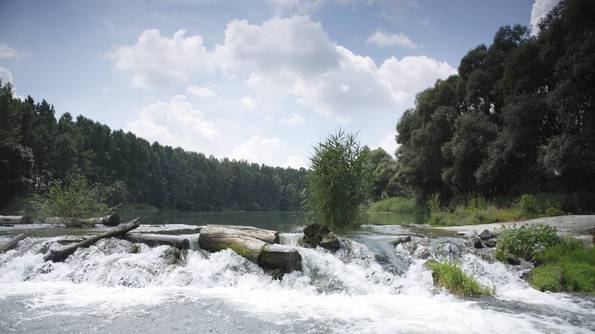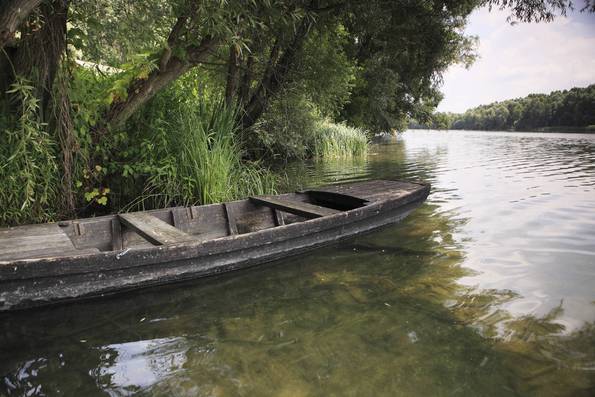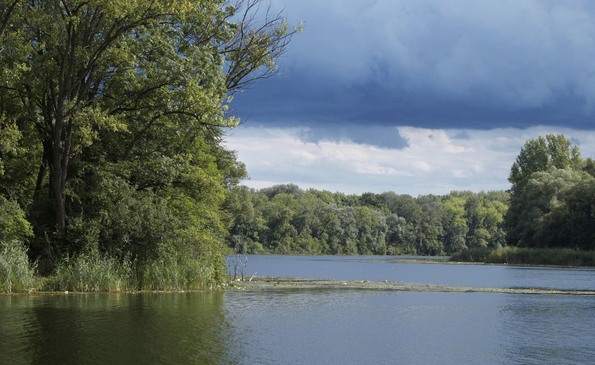 The floodplain forests and the swampy, marshy areas of the Danube (Hungarian: Duna) spread on the left bank of the river from Bratislava (Pozsony) as far as Zlatná na Ostrove (Csallóközaranyos), to the Veľkolélsky ostrov Island (Nagyléli sziget) belonging to the latter, and they form the protected areas of the Danube floodplain. This region is famous for its rare, protected bird life. The area of the marshland in the Rye Island (Hungarian: Csallóköz, Slovak: Žitný ostrov) was designated as a Ramsar site in 1993, which provides an international rank for it, and in 1998, it became one of the strictly protected landscape areas in Slovakia. The construction of the Gabčikovo (Bős) hydroelectric power plant has disrupted the biological unity of the area along the Danube, which was virgin until then. From this time on the area along the Danube is divided into five smaller, independent tracts.
The floodplain forests and the swampy, marshy areas of the Danube (Hungarian: Duna) spread on the left bank of the river from Bratislava (Pozsony) as far as Zlatná na Ostrove (Csallóközaranyos), to the Veľkolélsky ostrov Island (Nagyléli sziget) belonging to the latter, and they form the protected areas of the Danube floodplain. This region is famous for its rare, protected bird life. The area of the marshland in the Rye Island (Hungarian: Csallóköz, Slovak: Žitný ostrov) was designated as a Ramsar site in 1993, which provides an international rank for it, and in 1998, it became one of the strictly protected landscape areas in Slovakia. The construction of the Gabčikovo (Bős) hydroelectric power plant has disrupted the biological unity of the area along the Danube, which was virgin until then. From this time on the area along the Danube is divided into five smaller, independent tracts.
 The first two stretches are in the wider environs of Bratislava (Pozsony). These two major landscape entities are in the greatest danger, as they are in the immediate vicinity of the big city. The third stretch of the region is the largest, most widespread one formed by the distributaries full of twists and turns of the Danube and in its surroundings as well as the feeding canal of the hydroelectric power plant between Dobrohošť (Doborgaz) and Sap (Szap). The fourth stretch extends from community Sap (Szap) to Klížska Nemá (Kolozsnéma) and includes the distributaries, oxbows and backwaters of the Danube as well as the floodplain forests. The fifth, the easternmost stretch spreads from Veľké Kosihy (Nagykeszi) as far as Zlatná na Ostrove (Csallóközaranyos). Here you can find the branch of Veľký Lél (Nagylél) and the island of the same name (Veľkolélsky ostrov / Nagyléli sziget), where there are still virgin meadows, mortlakes and alluvial forests.
The first two stretches are in the wider environs of Bratislava (Pozsony). These two major landscape entities are in the greatest danger, as they are in the immediate vicinity of the big city. The third stretch of the region is the largest, most widespread one formed by the distributaries full of twists and turns of the Danube and in its surroundings as well as the feeding canal of the hydroelectric power plant between Dobrohošť (Doborgaz) and Sap (Szap). The fourth stretch extends from community Sap (Szap) to Klížska Nemá (Kolozsnéma) and includes the distributaries, oxbows and backwaters of the Danube as well as the floodplain forests. The fifth, the easternmost stretch spreads from Veľké Kosihy (Nagykeszi) as far as Zlatná na Ostrove (Csallóközaranyos). Here you can find the branch of Veľký Lél (Nagylél) and the island of the same name (Veľkolélsky ostrov / Nagyléli sziget), where there are still virgin meadows, mortlakes and alluvial forests.
 The Číčovské dead arm system (Csicsó backwater and its surroundings) is the most important area of the latter landscape entity, which has now been a nature reserve for fifty years. It is better known as the Lion Lake - this folk name is after a French soldier, who lived in a hut by the backwater bank in the first half of the last century. The Csicsó backwater is the largest oxbow on the Slovak reach of the Danube, which was created in 1899 by cutting off the flood-control embankment. The oxbow lake and its surroundings together with the protected area cover 134 hectares, from which the water surface is 76.5 hectares. The biggest depth of the lake is 7.5 meters. Its abundant flora and fauna as well as the stunning natural environment give the importance of this area. Incredibly many rare and strictly protected plants and animals live in this tract. The Lion Lake is surrounded a thick alluvial forest that is impenetrable in some places. At the edge of the area and in the shallow parts of oxbow lake, there are dense reeds providing habitat for many bird species. Incredibly many, about 107 species live in this tract, first of all waterfowls: herons, coots, mallards, great reed warbles, as well as forest birds: nightingales, black woodpeckers, reed warblers and blackbirds. From the fishes living in the oxbow lake the common carp and from those living in the swamp the endemic European mudminnow are to be mentioned in the first place. The nature reserve can be visited only on foot and on the designated nature trails, the lengths of which is 6 kilometres with 12 rest areas. In the area along the Danube, there is a cycle path on the flood-control embankment, on the south part of the protected area. In the brooding period of the birds (from 1 March to 15 July), visitors are not allowed to visit the nature reserve.
The Číčovské dead arm system (Csicsó backwater and its surroundings) is the most important area of the latter landscape entity, which has now been a nature reserve for fifty years. It is better known as the Lion Lake - this folk name is after a French soldier, who lived in a hut by the backwater bank in the first half of the last century. The Csicsó backwater is the largest oxbow on the Slovak reach of the Danube, which was created in 1899 by cutting off the flood-control embankment. The oxbow lake and its surroundings together with the protected area cover 134 hectares, from which the water surface is 76.5 hectares. The biggest depth of the lake is 7.5 meters. Its abundant flora and fauna as well as the stunning natural environment give the importance of this area. Incredibly many rare and strictly protected plants and animals live in this tract. The Lion Lake is surrounded a thick alluvial forest that is impenetrable in some places. At the edge of the area and in the shallow parts of oxbow lake, there are dense reeds providing habitat for many bird species. Incredibly many, about 107 species live in this tract, first of all waterfowls: herons, coots, mallards, great reed warbles, as well as forest birds: nightingales, black woodpeckers, reed warblers and blackbirds. From the fishes living in the oxbow lake the common carp and from those living in the swamp the endemic European mudminnow are to be mentioned in the first place. The nature reserve can be visited only on foot and on the designated nature trails, the lengths of which is 6 kilometres with 12 rest areas. In the area along the Danube, there is a cycle path on the flood-control embankment, on the south part of the protected area. In the brooding period of the birds (from 1 March to 15 July), visitors are not allowed to visit the nature reserve.
White-tailed Eagle Island
This area of the gallery forests along the Danube has been a National Nature Reserve since 1994. It is surrounded by the afterbay of the Gabčikovo (Bős) hydroelectric power plant, the Danube and a branch of Gabčikovo (Bős). On this regularly inundated alluvial island, many rare bird and plant species have their habitat; among others, also the white-tailed eagle has a nesting area here. Until recently, it seemed this gorgeous and large bird of prey would disappear from the island. However, after a longer period a white-tailed eagle pair built a nest again on the island.
In the area of Dunajské luhy Protected Landscape Area (literally Danube Floodplains PLA) there is another noteworthy protected area: the Veľkolélsky ostrov Island (Nagyléli sziget) in the outskirts of Zlatná na Ostrove (Csallóközaranyos) This is the last large island covering an area of 250 hectares on the Slovak reach of the Danube. The most intact part of its forests was designated as a nature reserve in 1974. The fauna and flora in the forests, wetlands and fen meadows of the Veľkolélsky ostrov Island (Nagyléli sziget) has become unique for now. By means of its beauties, it attracts a large number of visitors to the island.
Michal Deraj


